This is a translation of a prior post in Swedish. Se originalinlägget på svenska här >
This post is about the most common way of working for an agile team, namely the Scrum framework. Scrum is a minimal, lightweight framework that gives good support for both new teams and more experienced teams, as well as for organisations with many teams, under the name Scrum at Scale. In this post I show the basics of Scrum, but if you are interested to know more and get the latest correct updates, I recommend the official Scrum Guide >
Scrum is based on empiricism and lean thinking. It provides good support to deliver solutions to complex problems where we cannot predict whether the solution will produce the effect we want. It has become by far the most popular Agile way of working over the past 20 years.
The team can work within software development, product development, or as managers in any sort of organisation. Even functions like HR can benefit greatly from this way of working, or why not healthcare or construction projects? Anyone who works with complex problems where they cannot predict if the solution will achieve the desired result, and cannot plan more than one week in advance, will benefit from working this way of working.
Download the poster on Agile working for teams in a nutshell in English as high resolution PDF.
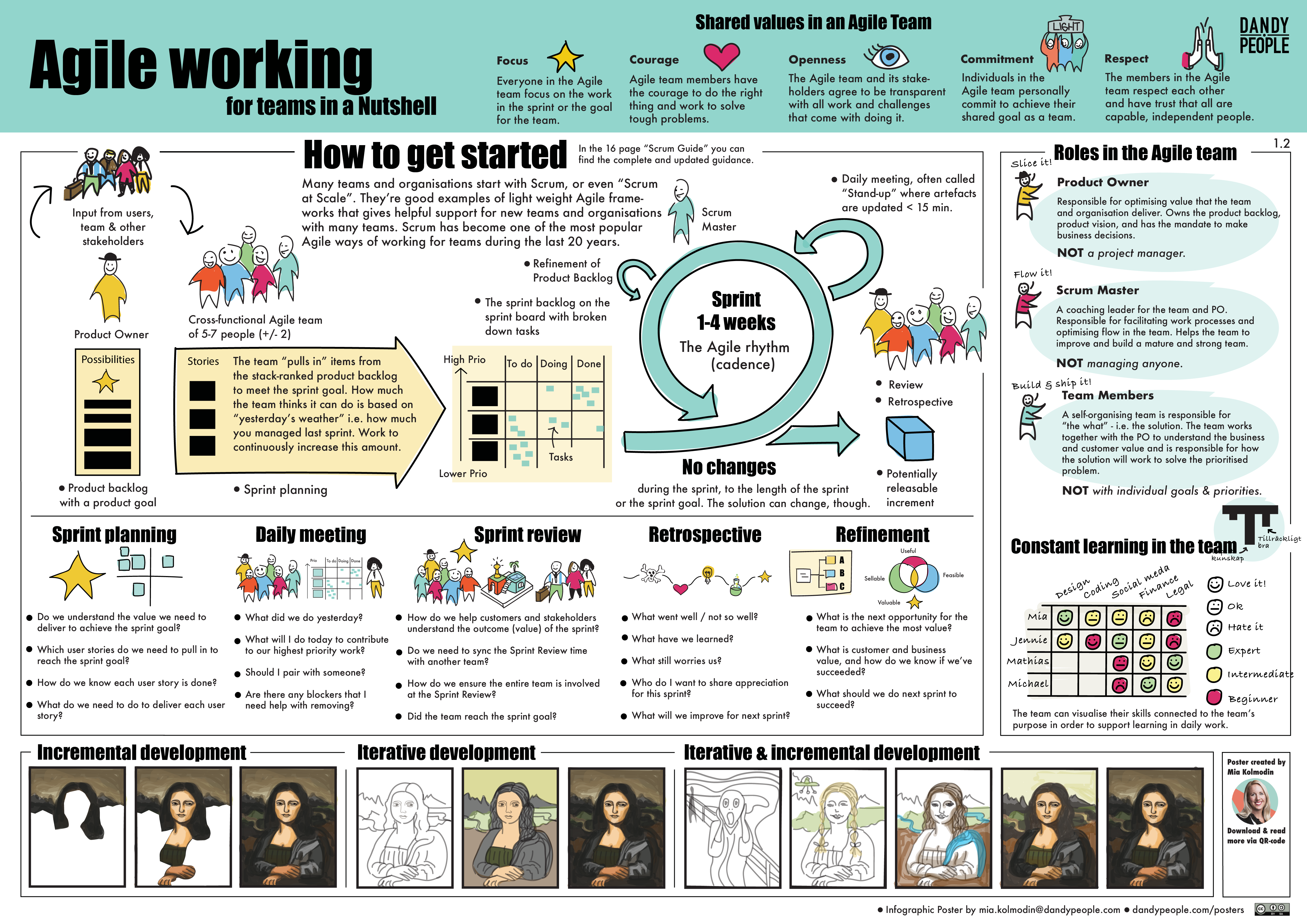
Share Values in the Agile Team
The 5 Scrum values give the team the conditions needed to build a high performing team. If these values are not lived by the team, they will not be able to build and maintain an Agile approach either. Process alone will not bring a team all the way to agility.

Focus
All in the Agile team focus on the work in the sprint or the goal for the team.
Courage
Agile team members have the courage to do the right thing and work to solve tough problems.
Openness
The Agile team and its stakeholders agree to be transparent with all work and challenges that come with doing it.
Commitment
Individuals in the Agile team personally commit to achieve their shared goal as a team.
Respect
The members in the Agile team respect each other and have trust that all are capable, independent people.
Agile way of working for teams
The process is simple and has few elements and rules, as well as only 3 roles; Product Owner, Scrum Master and Team Member. Regardless of what the team is working on, these roles are used, but depending on what the team’s mission is, the team members have different competencies (more on that below).
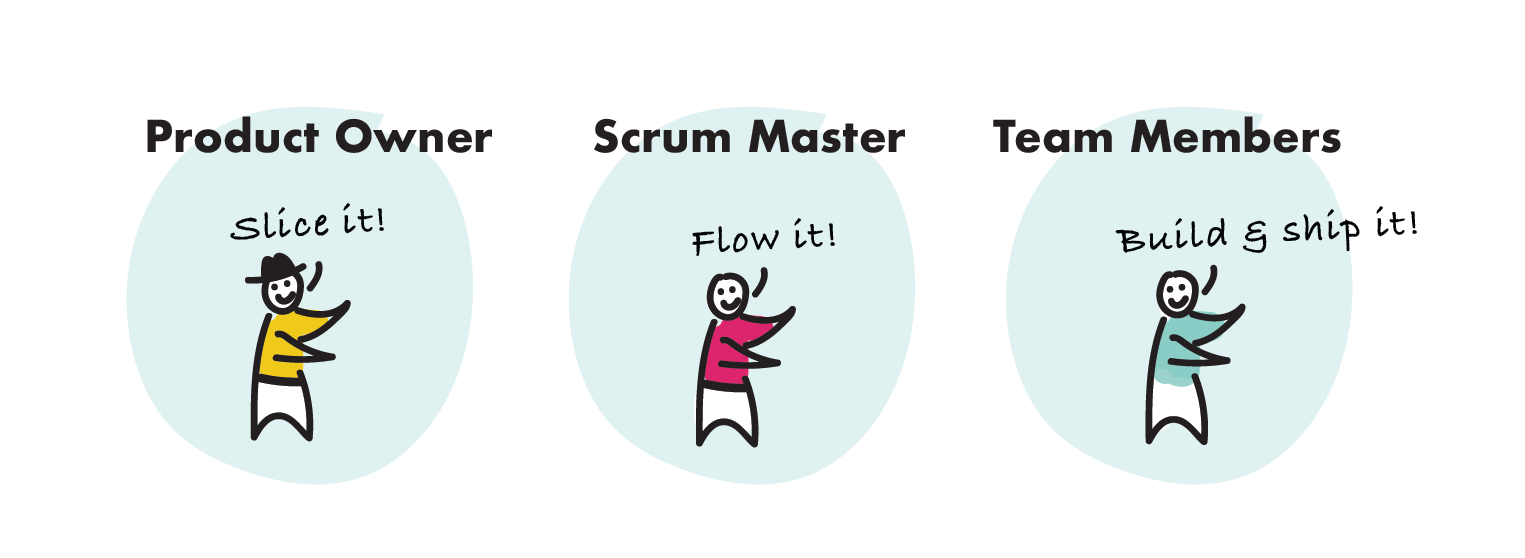
Product Owner
Responsible for optimising value that the team and organisation deliver. Owns the product backlog, product vision, and has the mandate to make business decisions. NOT a project manager.
Scrum Master
A coaching leader for the team and PO. Responsible for facilitating work processes and optimising flow in the team. Helps the team to improve and build a mature and strong team. NOT managing anyone.
Team Members
A self-organising team is responsible for “the what” – i.e. the solution. The team works together with the PO to understand the business and customer value and is responsible for how the solution will work to solve the prioritised problem. NOT with individual goals and priorities.
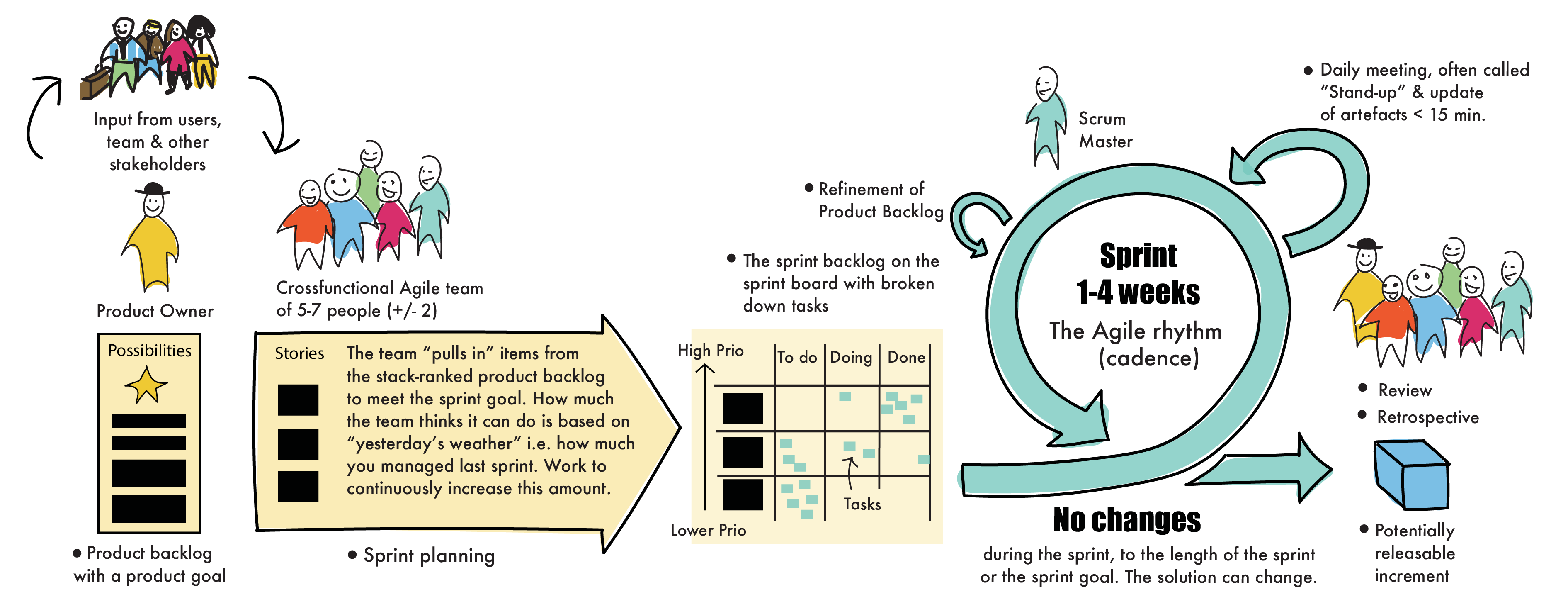
Agile working for teams
The process includes a number of activities that help the team collaborate and deliver value on an ongoing basis. When a sprint is over, the next one starts, which means that the process is continuously improved. The most important activity is therefore not the planning, but the retrospective that stands for the improvement. The team always plans for a sprint, and then has the opportunity to get feedback and improve both their process and their delivery in the next sprint.
Sprint Planning
– Do we understand the value we need to deliver to achieve the sprint goal?
– Which user stories do we need to “pull in” to achieve the sprint goal?
– How do we know a user story is done?
– What do we need to do to deliver each user story?
Daily Meeting
– What did we do yesterday?
– What will I do today to contribute to our highest priority work?
– Should I work with someone?
– Are there any blockers that I need help with removing?
Sprint Review
– How do we help customers and stakeholders understand the outcome (value) of the sprint?
– Do we need to sync the Sprint Review time with another team?
– How do we ensure the entire team is involved at the Sprint Review?
– Did the team reach the sprint goal?
Retrospective
– What went well / not so well?
– What have we learned?
– What still worries us?
– Who do I want to share appreciation for this sprint?
– What will we improve in the next sprint?
Refinement of the product backlog
– What is the next opportunity for the team to achieve the most value?
– What is customer and business value, and how do we know if we’ve succeeded?
– What should we do next sprint to succeed?
Continuous learning in the team
The team can visualise their skills, in connection with the team’s purpose, in order to support learning in daily work. In cross-functional teams, abilities are more important than roles. Team members who have a T-shaped skill profile improve team collaboration, delivery and flow and reduce risky dependencies on specific individuals. T-shaped skills double the speed of the team.

To solve complex problems and deal with uncertainty
Incremental work
Incremental working means that we deliver the solution step by step and that it is only useful when all parts are delivered. This can only be done if the solution is known before we start. If the solution gives us the effect we were looking for, we can work according to a waterfall process instead. Here, agility creates some value.
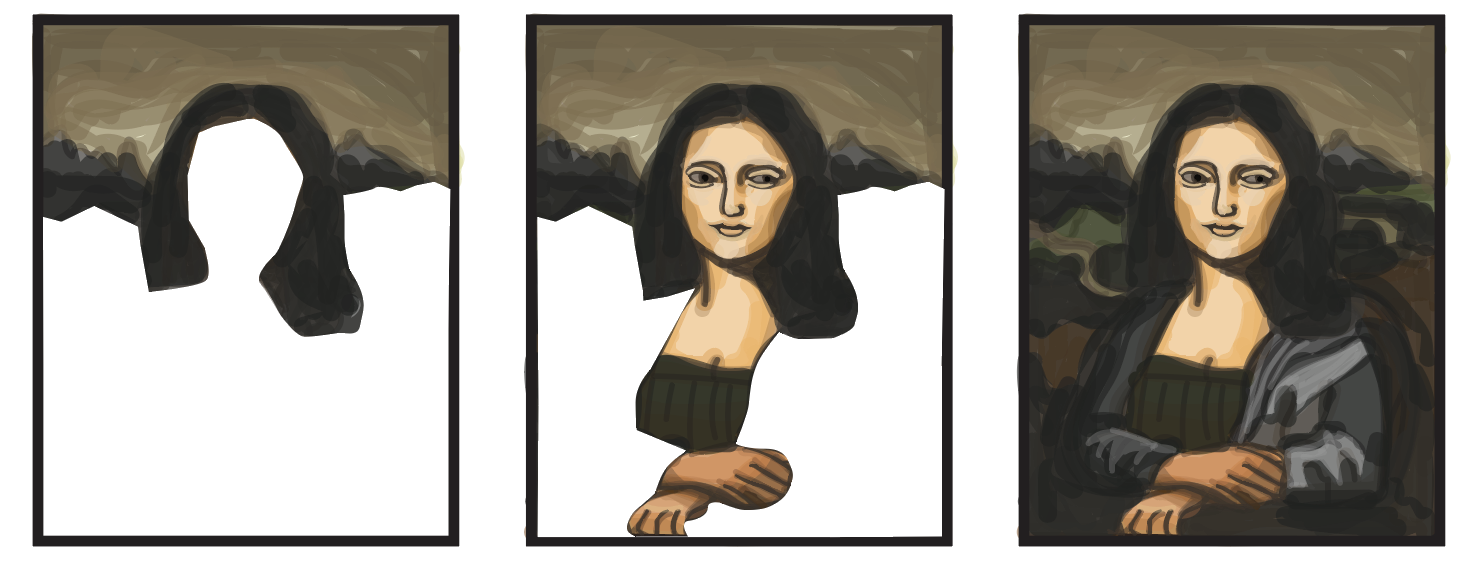
Iterative work
Iterative working means that we start with a sketch or outline, and gradually fill in more comprehensive detail. We start with a prototype and build up the solution through refinement. Here we need an initial idea of what we want, then get feedback step by step and determine when we are satisfied. Our delivery can provide value, even in the first step, in the form of feedback. Here we benefit from the agility and here Scrum provides strong support with ongoing short planning and deliveries as well as the possibility of replanning in the next sprint based on feedback.
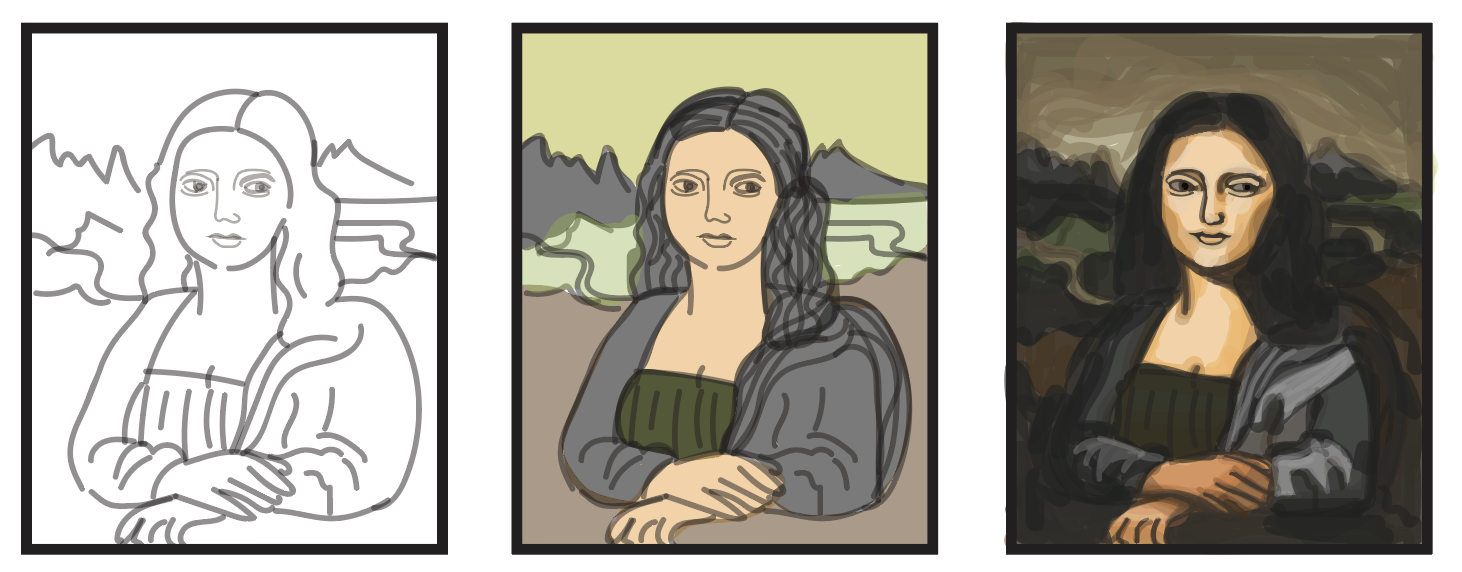
Incremental and iterative work
Using both incremental and iterative ways of working makes full use of agility and helps us best deal with uncertainty. Here we can find completely new solutions and test ourselves, step by step, and thereby reach the right result, even if our first idea was wrong. This minimises the risks of delivering the wrong solution in the shortest possible time. Scrum is very useful here if we have the skills to work with all the parts needed to experiment, prototype and get feedback to reach maximum value. If, on the other hand, the team has dependencies to other teams to be able to work incrementally and iteratively, then the team needs to work to reduce those dependencies to reach smoother collaboration and continuous delivery.

Download the poster on Agile working for teams in a nutshell in English as high resolution PDF.
Free to download, use and share
The posters are published under Creative Commons License, so please use it and share it as you like. If you are interested in doing a translation to any other languages please let me know and I will help you with the file and publish it here in the blog as well.
You are free to:
Share — copy and redistribute the material in any medium or format
Adapt — remix, transform, and build upon the material for any purpose, even commercially.
This license is acceptable for Free Cultural Works.
The licensor cannot revoke these freedoms as long as you follow the license terms.
Under the following terms:
Attribution — You must give appropriate credit, provide a link to the license, and indicate if changes were made. You may do so in any reasonable manner, but not in any way that suggests the licensor endorses you or your use.
ShareAlike — If you remix, transform, or build upon the material, you must distribute your contributions under the same license as the original.
No additional restrictions — You may not apply legal terms or technological measures that legally restrict others from doing anything the license permits.

Here you find all the other Free Agile in a Nutshell-posters in the series that is now translated to 14 languages and downloaded over 100.000 times worldwide.


